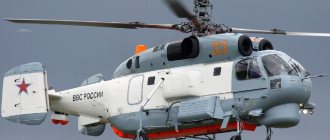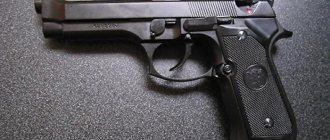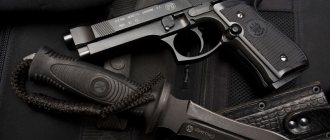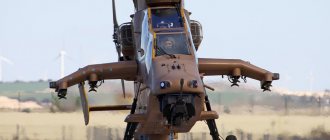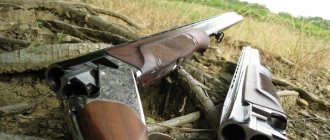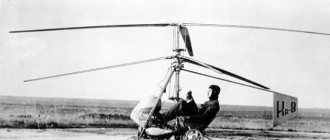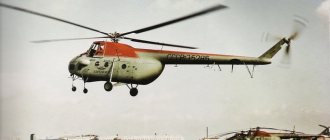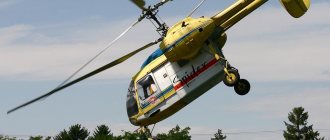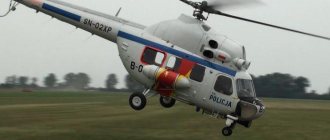Since the 50s, the development and production of helicopters in the USSR was divided between two design bureaus. Moreover, the Mikhail Mil Design Bureau developed a whole family of very successful general purpose helicopters - the light Mi-2, the medium Mi-8 and the heavy Mi-6. Nikolai Kamov's design bureau, which is developing coaxial helicopters, turned out to be practically in the niche of universal machines.
But Kamov helicopters took root where the coaxial design provided great advantages - in particular, in naval aviation. The development of deck-based vehicles of the multi-purpose Ka-28 family gave rise to the transport and combat Ka-29.
History of creation
Although the Soviet Marine Corps was not such a large and powerful structure as the American one, it was still an important branch of the armed forces. The Marines, in particular, were supposed to be the first to land on the coast, holding the bridgehead until the landing of the main forces - motorized rifles from transport and landing ships.
Helicopters were supposed to be used to quickly and efficiently transport Marine airborne assault groups. At the same time, the same vehicles were supposed to evacuate the wounded, transport ammunition, and most importantly, provide fire support, including destroying armored targets. A portrait was emerging of a kind of “flying infantry fighting vehicle” like the Mi-24, but taking into account naval specifics.
Since the late 60s, the Kamov Design Bureau has been developing a new shipborne helicopter, the Ka-27.
The main purpose of the "twenty-seventh" was the fight against enemy submarines and rescue operations. They decided to make a universal vehicle for the Marine Corps on its basis. Work under the leadership of Sergei Fomin began in 1973. The name “Ka-29” did not appear immediately; at first the helicopter was called Ka-27TB.
The first prototype with tail number “208” took off in the summer of 1976. Factory tests of the first two Ka-29s were completed in the spring of 1978, and the vehicles were immediately transferred to state tests. In May 1979, the Ka-29 (this name was finally approved) was recommended to be launched into series. But serial production of the “twenty-ninth” began only in 1984.
Modifications[ | ]
| Model name | Brief characteristics, differences. |
| Ka-252TB | Prototype, two helicopters built. |
| Ka-29 | Serial transport and combat helicopter. |
| Ka-29VPNTSU | The target designator helicopter was converted in a single copy for joint military tests with the Ka-50. |
| Ka-29 approach system adjuster | Two production helicopters were converted to test and configure the approach system for the TAVKR "Admiral of the Fleet of the Soviet Union Kuznetsov" |
| Ka-29 flying laboratory | Single-seat helicopter for testing on-board equipment Ka-50 |
| Ka-31 (Ka-27RLD) | AWACS helicopter. |
Design
The Ka-29 helicopter is a universal transport and combat vehicle, built according to a scheme with 2 coaxial propellers. All-metal fuselage - semi-monocoque type. In the bow of the “twenty-ninth”, between the first and fourth frames of the power set, there is a pilot’s cabin. Behind it is a cargo compartment that can accommodate 16 paratroopers or 6 wounded.
If the wounded are transported on stretchers, capacity is reduced to 4 people. When transporting cargo, the cabin can accommodate up to 2 tons. On an external sling, the Ka-29 can transport up to 4 tons.
The floor of the cargo compartment and the power set form compartments containing fuel tanks.
The compartment between the fourth and fourteenth frames is a bomb bay, but an additional tank can be installed in it. Inside the tail boom of the “twenty-ninth” there is equipment, and the empennage is attached to it outside – 2 fins and a stabilizer. The chassis is 4-wheel, non-retractable.
The Ka-29 is equipped with 2 TV3-117KM turboshaft engines. The engines have a 12-stage compressor and a 2-stage turbine and develop a rated power of 1,700 horsepower. Torque is transmitted to the propellers by a gearbox, from which hydraulic pumps and generators are also driven. The engines of the “twenty-ninth” are started by a pneumatic starter, the air for which is pumped by the auxiliary gas turbine engine AI-9.
The three-blade propellers of the Ka-29 are fiberglass. Control system – with hydraulic boosters. The helicopter is equipped with an automatic fire extinguishing system and manual fire extinguishers to extinguish fires in the cabins. The cabins and glazing of the Ka-29 are heated by air exhausted from the right engine.
The PKV-252 flight control system, which includes an autopilot, allows for semi-automatic control of the helicopter. The twenty-ninth navigation complex - NKV-252 includes a radio compass, a beacon navigation system, a Doppler speed meter and a radio altimeter.
In service[ | ]
Is in service[ | ]
Russia:
- Aviation of the Russian Navy - 27 Ka-29 for 2022, assigned to, Pacific Fleet and .[7] 12 repaired units at the Pacific Fleet as of November 2022.
- a detachment of repaired helicopters at (Donskoye airfield in the Kaliningrad region) for November 2022.
Ukraine:
- Aviation of the Ukrainian Navy - 4 Ka-29, as of 2022[8]. After the collapse of the USSR, Ukraine received 5 Ka-29s, which were in service with the 555th Instructor and Research Anti-Submarine Mixed Aviation Regiment (Ochakov).
Equatorial Guinea - 1 Ka-29 as of 2016, purchased from Ukraine in 2011[9][10].
Was in service[ | ]
THE USSR:
- Aviation of the USSR Navy
Armament
A 7.62 mm GShG machine gun is installed in the nose of the helicopter. The rate of fire of this 4-barreled machine gun, made according to the Gatling system, ranges from 3500 to 6000 rounds per minute, the ammunition capacity is 1800 rounds. The navigator aims the machine gun through the K-10T collimator sight.
On the left side of the fuselage there is a 30 mm 2A42 cannon, similar to that used on the Ka-50 and BMP-2.
Its ammunition load is 250 rounds. The gun is aimed at the target by the pilot using the ASP-17VK sight. Unlike the K-10T sight, it is connected to a laser rangefinder, and the ballistic computer automatically generated lead angles, including those for target movement. In addition, paratroopers could install machine guns in the cargo door openings.
Up to 8 Sturm anti-tank missiles with a launch range of up to 5 km and guidance by radio commands could be installed on the external sling of the “twenty-ninth”. It is also possible to suspend blocks of S-5 unguided missiles of 57 mm caliber (up to 128 missiles) or S-8 80 mm caliber (up to 80 missiles). It was planned to install gun containers with 23 mm caliber guns and incendiary tanks.
Notes[ | ]
- ↑ 12
KumAPP Archived copy from September 13, 2007 on the Wayback Machine - Media: The Navy has decided on helicopter groups for the Mistrals
- Shipborne transport and combat helicopter Ka-29
- The ship's Ka-29 helicopters were repaired for the Pacific Fleet. 12/21/2016
- Six Ka-29 helicopters that have undergone repairs have arrived at the Pacific Fleet air base. 9.11.2017
- The updated carrier-based Ka-29s have returned to the Baltic Fleet. 11/21/2017
- The Military Balance 2016, p.193
- The Military Balance 2022, p.229
- Ka-29 Equatorial Guinea
- The Military Balance 2016, p. 443
Exploitation
The Ka-29 was officially put into service in 1987 - 9 years after the end of testing. They were supposed to equip large landing ships of Project 1174, in addition, the “twenty-ninths” were supposed to be part of the air groups of Soviet aircraft-carrying cruisers, including promising ones. However, before the collapse of the Soviet Union, they managed to build only 3 ships of Project 1174, and the aircraft carrier Admiral Kuznetsov.
In addition, in 1987 and 1988, 2 accidents occurred with the “twenty-ninth” - during a training flight over the sea and while taking off from a ship. All this led to the fact that the Ka-29 was operated mainly from ground airfields.
In 1987, they tried to test the “twenty-ninth” in combat conditions in Afghanistan. At the Uzbek airfield in Chirchik, the Ka-29 was actively tested for combat use, but the Kamov vehicles were never allowed into Afghanistan.
After 1991, difficult times came for the unique car.
“Twenty-niners” were few, they practically never went to sea, and generally flew little - there was no means to extend their service life.
An attempt to save the Ka-29 was the idea of a “combat strike group”, which was advocated by Major General Vorobyov, who highly appreciated the vehicles of the Kamov Design Bureau. Within the framework of this concept, the “twenty-ninths” were supposed to work as reconnaissance target designators for the “Black Sharks” Ka-50. Instead of the GShG machine gun, the ABRIS navigation system, a thermal imager, and new sighting equipment were installed on 2 helicopters.
In 2001, the strike group finally got to military tests in Chechnya, where the Ka-29 flew for 27 hours and fired 184 unguided missiles. Despite the fact that the results of the application were found to be satisfactory and the shortcomings were removable, the program was soon closed. The Ka helicopters were unable to displace the Mi-24 and Mi-28.
By 2014, there were no more than 15 Ka-29s in naval aviation units, and even those were mothballed. However, in 2022, information appeared that the “twenty-ninths” were being repaired and returned to service in the Pacific and Baltic fleets.
The helicopters remaining in the Ukrainian fleet were quite actively used in various exercises, as well as for transporting command personnel.
In 2012, only 3 “twenty-ninths” remained in service; since 2014, they have been listed as unfit for flight. Only 1 helicopter was sent “for export” - the Ukrainians sold it to Equatorial Guinea.
The “fighting snail” is ahead of the entire system
At the same time, the Kamov machine is a good and time-tested transport helicopter. Its capabilities can be effectively used when transferring cargo or personnel between ships, during landing operations with landing on the coast and prompt delivery of reinforcements and ammunition to the landing party. In terms of its armament, the Ka-29 is also very effective in assault support of the Marine Corps. If necessary, these vehicles can be part of air groups of warships. This is what was demonstrated during the recent large-scale command and staff exercises “Zapad-2021”, exercises of the permanent group of the Russian Navy in the Mediterranean Sea and naval groups of the Pacific Fleet.
According to naval aviation experts, the optimal composition of individual Ka-29 helicopter detachments of each military fleet will be from four to eight combat vehicles. Representatives of the military-industrial complex express confidence that today it is possible to modernize a further number of these universal vehicles, which are in demand for the development of naval structures. The “porridge” returned to combat formation by naval aviation is effective in landing troops and special forces groups, and patrolling water areas. Moreover, the conversion of this helicopter from transport to combat and vice versa is carried out in ship conditions. The Ka-29 can be sent on long voyages on large anti-submarine ships of Project 1155, which at one time showed themselves well in anti-terrorist actions against sea pirates. In addition, it is advisable to equip Project 22160 patrol ships of the Dmitry Rogachev type and new frigates with helicopter decks with these helicopters. The capabilities of the Ka-29 can be successfully implemented in Arctic defense projects. There is no doubt that this rotary-wing combat vehicle, which has stood the test of time, remains in demand due to the successful combination of its firepower, transport characteristics and unique capabilities of an amphibious assault vehicle.
Direct speech
“The Ka-29 is a slightly underrated, but very powerful machine. The helicopter behaves perfectly in the air. It is very stable - this is due to the fact that its cabin is 50 centimeters wider due to the new layout. And apparently this is why this helicopter shows higher stability and controllability characteristics. That is, he, like an “iron”, stands in the air. It goes very well at speeds of 270-290 km/h without any shaking. It turned out to be almost as fast as the Mi-2.”
Alexander Cherednichenko, test pilot 1st class at Kamov JSC.
Flight performance
As a helicopter for landing and fire support of amphibious assault, the Ka-29, perhaps, had no analogues. In the US Marine Corps, the main medium transport helicopter is the UH-1Z, a modernization of the old Iroquois.
| Ka-29 | UH-1Z Venom | |
| Crew+troops | 2+16 | 2+18 |
| Length, m | 12,25 | 13,6 |
| Main rotor diameter, m | 15,9 | 14,8 |
| Take-off weight, t | 11,5 | 8,4 |
| Load capacity, t | 2 | 3 |
| Maximum speed, km/h | 280 | 304 |
| Range, km | 460 | 648 |
So, in terms of characteristics as a machine for transporting troops, the American helicopter, despite its age, can easily compete with the “twenty-ninth”. It is, of course, less armed - it is allowed to install large-caliber machine guns in the openings of cargo doors and 2 blocks of unguided missiles. Thus, the strike version of the Ka-29 is comparable to the AH-1Z helicopter.
Opinions about the Ka-29 helicopter differed. Some believed that the “twenty-ninth” could replace the Mi-24 and become the main combat helicopter not only of the fleet, but also of the army. They objected to this: the fuel supply is small, the car is unsuitable for long-term taxiing.
The tire pressure in the Ka-29 chassis is selected so that it is difficult to land on rough terrain.
Among the weapon systems, the GShG machine gun turned out to be the “weak link”, which does not allow effective firing without entering the kill zone from small arms. But everyone agreed that the “twenty-ninth” was exactly what the naval paratroopers needed.
Modernizations and repairs[ | ]
| This article or section needs revision. Please improve the article in accordance with the rules for writing articles. |
- In 2012, it was planned to modernize 10 Ka-29 transport and combat helicopters intended for Mistral-type UDCs. Modernization consists of installing modern weapons and radio-electronic base.
- In December 2016, the repair of a batch of 6 Ka-29s was completed, which will arrive at the Pacific Fleet. The main rotor columns, engines and gearboxes on the helicopters were overhauled, and the paintwork was updated[4].
- The next batch of 6 aircraft, which underwent a scheduled mid-life repair at the Kumertau Aviation Production Enterprise, arrived at the Naval Aviation Air Base of the Pacific Fleet Nikolaevka in the Primorsky Territory on November 9, 2017[5].
- In November 2022, at the Donskoye airfield in the Kaliningrad region, a detachment of updated Ka-29s was put into operation, having undergone repairs at the 150th aircraft repair plant[6].
